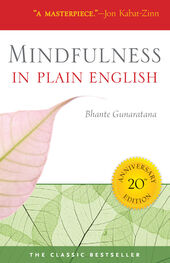Here is another example: You are sitting in meditation and a sound strikes your ear. It is just an indistinct noise, sort of a muffled crunch; it could be anything. What happens next will probably be something like this. “What was that? Who did that? Where did that come from? How far away was that? Is it dangerous?” And on and on you go, getting no answers but your fantasy projection. Conceptualization is an insidiously clever process. It creeps into your experience, and it simply takes over. When you hear a sound in meditation, pay bare attention to the experience of hearing. That and that only. What is really happening is so utterly simple that we can and do miss it altogether. Sound waves are striking the ear in a certain unique pattern. Those waves are being translated into electrical impulses within the brain and those impulses present a sound pattern to consciousness. That is all. No pictures. No mind movies. No concepts. No interior dialogues about the question. Just noise. Reality is elegantly simple and unadorned. When you hear a sound, be mindful of the process of hearing. Everything else is just added chatter. Drop it. The same rule applies to every sensation, every emotion, every experience you may have. Look closely at your own experience. Dig down through the layers of mental bric-a-brac and see what is really there. You will be amazed how simple it is, and how beautiful.
There are times when a number of sensations may arise at once. You might have a thought of fear, a squeezing in the stomach and an aching back and an itch on your left earlobe, all at the same time. Don’t sit there in a quandary. Don’t keep switching back and forth or wondering what to pick. One of them will be strongest. Just open yourself up and the most insistent of these phenomena will intrude itself and demand your attention. So give it some attention just long enough to see it fade away. Then return to your breathing. If another one intrudes itself, let it in. When it is done, return to the breathing.
This process can be carried too far, however. Don’t sit there looking for things to be mindful of. Keep your mindfulness on the breath until something else steps in and pulls your attention away. When you feel that happening, don’t fight it. Let you attention flow naturally over to the distraction, and keep it there until the distraction evaporates. Then return to breathing. Don’t seek out other physical or mental phenomena. Just return to breathing. Let them come to you. There will be times when you drift off, of course. Even after long practice you find yourself suddenly waking up, realizing you have been off the track for some while. Don’t get discouraged. Realize that you have been off the track for such and such a length of time and go back to the breath. There is no need for any negative reaction at all. The very act of realizing that you have been off the track is an active awareness. It is an exercise of pure mindfulness all by itself.
Mindfulness grows by the exercise of mindfulness. It is like exercising a muscle. Every time you work it, you pump it up just a little. You make it a little stronger. The very fact that you have felt that wake-up sensation means that you have just improved your mindfulness power. That means you win. Move back to the breathing without regret. However, the regret is a conditioned reflex and it may come along anyway—another mental habit. If you find yourself getting frustrated, feeling discouraged, or condemning yourself, just observe that with bare attention. It is just another distraction. Give it some attention and watch it fade away, and return to the breath.
The rules we have just reviewed can and should be applied thoroughly to all of your mental states. You are going to find this an utterly ruthless injunction. It is the toughest job that you will ever undertake. You will find yourself relatively willing to apply this technique to certain parts of your experience, and you will find yourself totally unwilling to use it on the other parts.
Meditation is a bit like mental acid. It eats away slowly at whatever you put it on. We humans are very odd beings. We like the taste of certain poisons and we stubbornly continue to eat them even while they are killing us. Thoughts to which we are attached are poison. You will find yourself quite eager to dig some thoughts out by the roots while you jealously guard and cherish certain others. That is the human condition.
Vipassana meditation is not a game. Clear awareness is more than a pleasurable pastime. It is a road up and out of the quagmire in which we are all stuck, the swamp of our own desires and aversions. It is relatively easy to apply awareness to the nastier aspects of your existence. Once you have seen fear and depression evaporate in the hot, intense beacon of awareness, you want to repeat the process. Those are the unpleasant mental states. They hurt. You want to get rid of those things because they bother you. It is a good deal harder to apply that same process to mental states which you cherish, like patriotism, or parental protectiveness or true love. But it is just as necessary. Positive attachments hold you in the mud just as assuredly as negative attachments. You may rise above the mud far enough to breathe a bit more easily if you practice Vipassana meditation with diligence. Vipassana meditation is the road to Nibbana. And from the reports of those who have toiled their way to that lofty goal, it is well worth every effort involved.
Chapter 13
Mindfulness (Sati)
Mindfulness is the English translation of the Pali word Sati . Sati is an activity. What exactly is that? There can be no precise answer, at least not in words. Words are devised by the symbolic levels of the mind and they describe those realities with which symbolic thinking deals. Mindfulness is pre-symbolic. It is not shackled to logic. Nevertheless, Mindfulness can be experienced—rather easily—and it can be described, as long as you keep in mind that the words are only fingers pointing at the moon. They are not the thing itself. The actual experience lies beyond the words and above the symbols. Mindfulness could be describes in completely different terms than will be used here and each description could still be correct.
Mindfulness is a subtle process that you are using at this very moment. The fact that this process lies above and beyond words does not make it unreal—quite the reverse. Mindfulness is the reality which gives rise to words—the words that follow are simply pale shadows of reality. So, it is important to understand that everything that follows here is analogy. It is not going to make perfect sense. It will always remain beyond verbal logic. But you can experience it. The meditation technique called Vipassana (insight) that was introduced by the Buddha about twenty-five centuries ago is a set of mental activities specifically aimed at experiencing a state of uninterrupted Mindfulness.
When you first become aware of something, there is a fleeting instant of pure awareness just before you conceptualize the thing, before you identify it. That is a stage of Mindfulness. Ordinarily, this stage is very short. It is that flashing split second just as you focus your eyes on the thing, just as you focus your mind on the thing, just before you objectify it, clamp down on it mentally and segregate it from the rest of existence. It takes place just before you start thinking about it—before your mind says, “Oh, it’s a dog.” That flowing, soft-focused moment of pure awareness is Mindfulness. In that brief flashing mind-moment you experience a thing as an un-thing. You experience a softly flowing moment of pure experience that is interlocked with the rest of reality, not separate from it. Mindfulness is very much like what you see with your peripheral vision as opposed to the hard focus of normal or central vision. Yet this moment of soft, unfocused, awareness contains a very deep sort of knowing that is lost as soon as you focus your mind and objectify the object into a thing. In the process of ordinary perception, the Mindfulness step is so fleeting as to be unobservable. We have developed the habit of squandering our attention on all the remaining steps, focusing on the perception, recognizing the perception, labeling it, and most of all, getting involved in a long string of symbolic thought about it. That original moment of Mindfulness is rapidly passed over. It is the purpose of the above mentioned Vipassana (or insight) meditation to train us to prolong that moment of awareness.
Читать дальше





